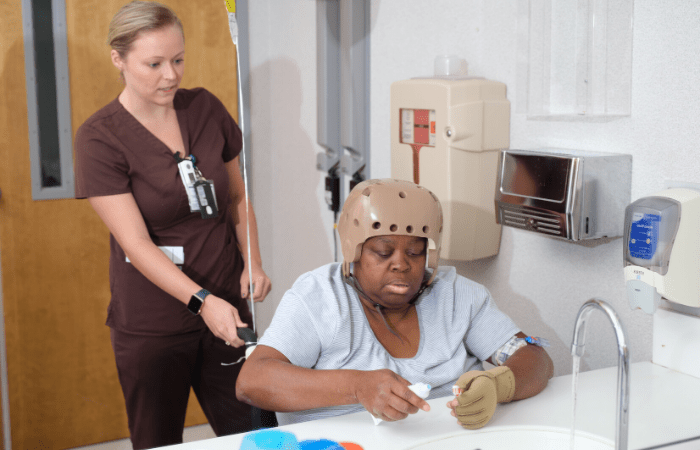
For people who suffer a serious injury or medical condition that reduces their mobility, strength, or physical or mental ability, the first goal of treatment is surviving the early stages. A full recovery, however, goes beyond survival and toward regaining everyday physical function. Occupational therapy (OT) is the rehabilitation process that helps patients get back the basic abilities that were affected.
Through various assessments and treatments, occupational therapists promote skill and independence in all daily activities, such as self-care, homemaking, leisure, and work. The goal is to have patients return to the “occupation of living,” says UAB Medicine OT Clinical Specialist Sarah Savage.
“OT is almost entirely function-based,” Savage says. “By that we mean the functions of day-to-day life that make a person independent. The essential mission of our therapy is getting patients back to their routine at the highest level possible, based on their functional abilities prior to needing hospitalization. We try to redevelop their ability to care for themselves with tasks you might take for granted, such as bathing, going to the toilet, moving throughout their household, getting dressed, or preparing a meal. Until a severe medical event happens, it’s easy to forget that an illness or injury can take away all of that.”
An injury or chronic pain may limit upper body motion and motor skills. A head injury, stroke, or other nervous system trauma can limit both mental and motor skills required for the simplest tasks. Patients may suffer a weakened grasp or struggle to button a shirt or open a container. In such cases, patients may be capable of living outside a hospital environment, but they are still on a path to recovery.
A Path to Independence
“During the acute phase, at the main campus or at UAB Hospital-Highlands, an OT will come in and work with a patient toward discharge to home or the next level of care,” Savage says. “After the injury, patients may move on to some form of rehab and possibly receive treatment at Spain Rehab if they still have some medical complexity but don’t need hospitalization.”
Patients may benefit from OT services in various ways, such as symptom management for fatigue, pain, limited range of motion, weakness, and mental impairments. They can learn energy conservation and task-simplification techniques, develop strategies for managing any mental issues arising from chemotherapy, and receive return-to-work training, family and caregiver training, and education on community resources.
Occupational therapists are skilled in assessing the impact of developmental, physical, and mental health conditions on a person’s ability to participate in meaningful activities that are important to their quality of life. They create care plans that help patients avoid disease or situations that might affect the recovery process, and they often support individuals in maintaining healthy lifestyles, which in turn can enhance their rehab efforts. Also, by working in partnership with other caregivers, OTs can ease the pressure on the patient’s primary care doctor and further reduce the risk of going back to a hospital or clinic due to falls and other incidents.
The main priority for OT, however, is what every patient wishes for: a return to normal.
“Patients want to begin a path to the independence they once had and return to their home environment,” Savage says. “In those circumstances, OT is a vital part of the rehab process, because patients need to go well beyond just surviving. Getting patients back to their highest possible functional level after a life-changing event is our priority.”
Click here to learn more about the services provided by UAB Physical Medicine and Rehabilitation (PM&R).
